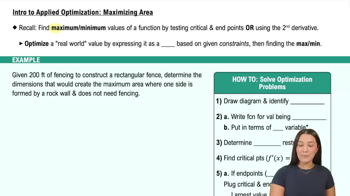Your company can manufacture x hundred grade A tires and y hundred grade B tires a day, where 0 ≤ x ≤ 4 and y = (40 - 10x)/(5-x). Your profit on a grade A tire is twice your profit on a grade B tire. What is the most profitable number of each kind to make?
Table of contents
- 0. Functions7h 54m
- Introduction to Functions16m
- Piecewise Functions10m
- Properties of Functions9m
- Common Functions1h 8m
- Transformations5m
- Combining Functions27m
- Exponent rules32m
- Exponential Functions28m
- Logarithmic Functions24m
- Properties of Logarithms36m
- Exponential & Logarithmic Equations35m
- Introduction to Trigonometric Functions38m
- Graphs of Trigonometric Functions44m
- Trigonometric Identities47m
- Inverse Trigonometric Functions48m
- 1. Limits and Continuity2h 2m
- 2. Intro to Derivatives1h 33m
- 3. Techniques of Differentiation3h 18m
- 4. Applications of Derivatives2h 38m
- 5. Graphical Applications of Derivatives6h 2m
- 6. Derivatives of Inverse, Exponential, & Logarithmic Functions2h 37m
- 7. Antiderivatives & Indefinite Integrals1h 26m
- 8. Definite Integrals4h 44m
- 9. Graphical Applications of Integrals2h 27m
- 10. Physics Applications of Integrals 3h 16m
- 11. Integrals of Inverse, Exponential, & Logarithmic Functions2h 31m
- 12. Techniques of Integration7h 41m
- 13. Intro to Differential Equations2h 55m
- 14. Sequences & Series5h 36m
- 15. Power Series2h 19m
- 16. Parametric Equations & Polar Coordinates7h 58m
5. Graphical Applications of Derivatives
Applied Optimization
Problem 4.5.30
Textbook Question
30. Find a positive number for which the sum of its reciprocal and four times its square is the smallest possible.
 Verified step by step guidance
Verified step by step guidance1
Define the positive number as \( x \). We need to minimize the function \( f(x) = \frac{1}{x} + 4x^2 \).
To find the minimum, first compute the derivative of \( f(x) \). The derivative is \( f'(x) = -\frac{1}{x^2} + 8x \).
Set the derivative \( f'(x) \) equal to zero to find critical points: \( -\frac{1}{x^2} + 8x = 0 \).
Solve the equation \( -\frac{1}{x^2} + 8x = 0 \) for \( x \). This involves finding a common denominator and solving the resulting equation.
Verify that the critical point found is a minimum by using the second derivative test. Compute \( f''(x) \) and check its sign at the critical point.
 Verified video answer for a similar problem:
Verified video answer for a similar problem:This video solution was recommended by our tutors as helpful for the problem above
Video duration:
3mPlay a video:
Was this helpful?
Key Concepts
Here are the essential concepts you must grasp in order to answer the question correctly.
Optimization
Optimization involves finding the maximum or minimum value of a function within a given set of constraints. In this problem, we aim to find the positive number that minimizes the expression involving its reciprocal and four times its square. This requires setting up a function to represent the scenario and using calculus techniques to find its minimum value.
Recommended video:

Intro to Applied Optimization: Maximizing Area
Derivatives
Derivatives are a fundamental tool in calculus used to determine the rate of change of a function. To find the minimum value of the function in this problem, we need to compute its derivative and find the critical points where the derivative is zero or undefined. These points are potential candidates for the minimum value of the function.
Recommended video:

Derivatives
Critical Points and Second Derivative Test
Critical points occur where the derivative of a function is zero or undefined, indicating potential maxima, minima, or inflection points. The second derivative test helps determine the nature of these critical points. If the second derivative is positive at a critical point, the function has a local minimum there, which is essential for solving this optimization problem.
Recommended video:

The Second Derivative Test: Finding Local Extrema

 1:13m
1:13mWatch next
Master Intro to Applied Optimization: Maximizing Area with a bite sized video explanation from Patrick
Start learningRelated Videos
Related Practice
Textbook Question
